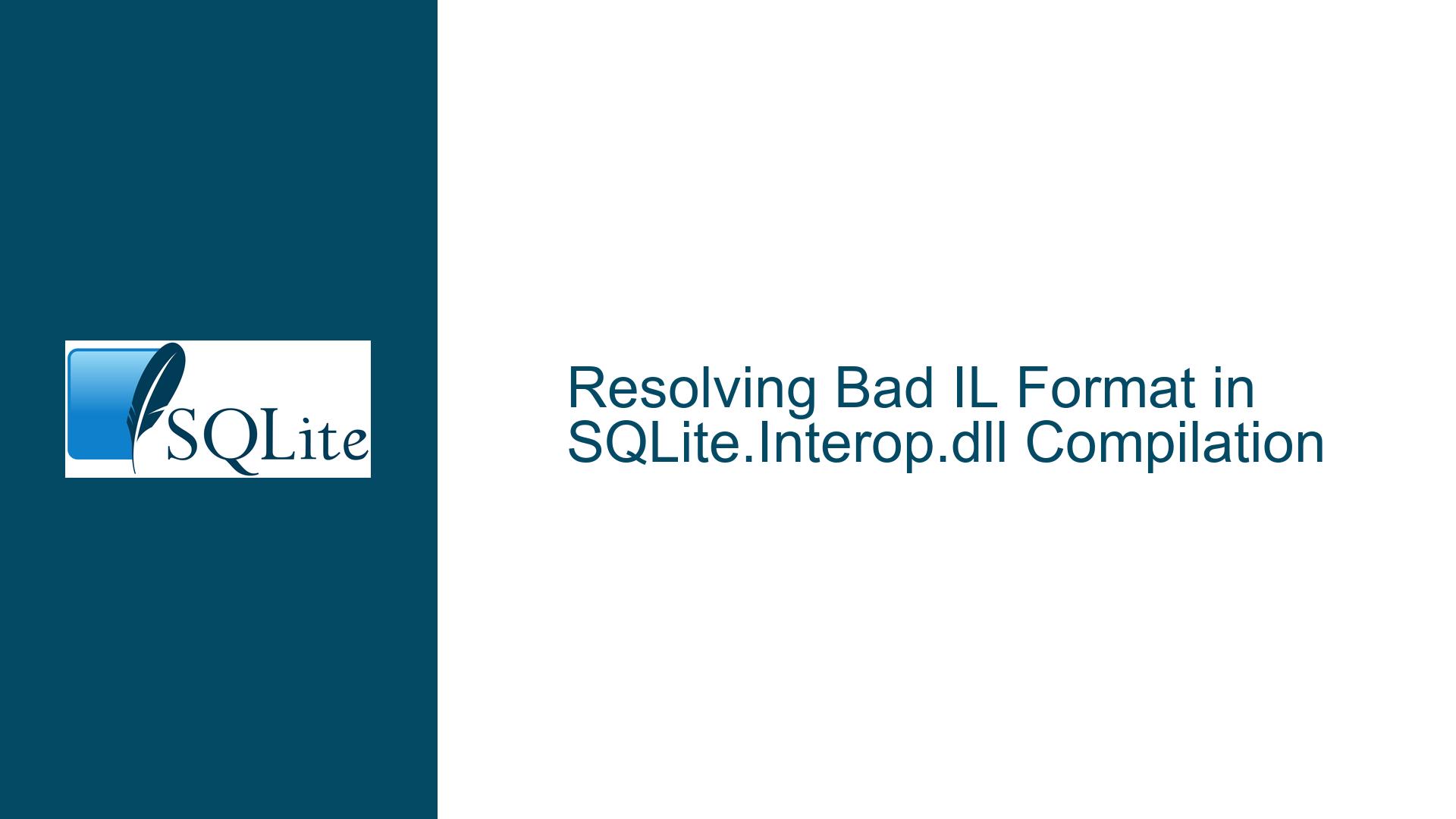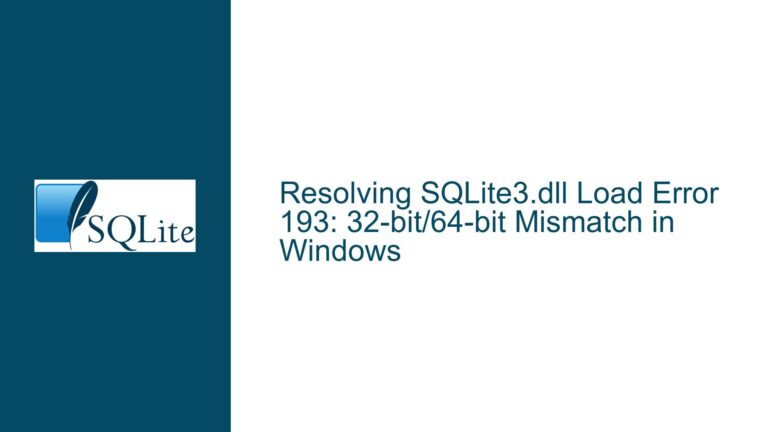Resolving Bad IL Format in SQLite.Interop.dll Compilation
Issue Overview: Bad IL Format in SQLite.Interop.dll During Compilation
When working with SQLite in a .NET environment, developers often encounter a specific issue related to the SQLite.Interop.dll file. This issue manifests as a warning or error during the compilation of a function app, stating that the compiler "cannot evaluate this because of bad IL." This error is particularly perplexing because SQLite.Interop.dll is a native DLL that does not contain Intermediate Language (IL) code, which is the bytecode that .NET compilers typically work with. The presence of this error suggests that the development environment is incorrectly attempting to interpret the native DLL as if it were a managed assembly containing IL.
The SQLite.Interop.dll is a critical component in SQLite’s architecture when used in .NET applications. It serves as the bridge between the managed .NET code and the native SQLite library, allowing .NET applications to interact with SQLite databases. However, because it is a native DLL, it does not contain IL, and thus, it should not be referenced directly in a .NET project as if it were a managed assembly. Instead, the correct approach is to reference a managed wrapper such as System.Data.SQLite.dll, which contains the necessary IL code to interact with the native SQLite.Interop.dll.
The confusion often arises from the way SQLite is distributed and referenced in .NET projects. SQLite provides both the native SQLite.Interop.dll and managed assemblies like System.Data.SQLite.dll. The managed assemblies are designed to be referenced directly in .NET projects, while the native DLLs are meant to be deployed alongside the application but not referenced directly in the project. When a developer mistakenly references SQLite.Interop.dll directly, the .NET compiler attempts to process it as a managed assembly, leading to the "bad IL" error.
This issue is not just a simple misconfiguration; it reflects a deeper misunderstanding of how SQLite integrates with .NET applications. The SQLite.Interop.dll is a native binary, and as such, it cannot be treated like a managed assembly. The .NET runtime expects managed assemblies to contain IL code, which can be Just-In-Time (JIT) compiled into machine code at runtime. Native DLLs, on the other hand, contain precompiled machine code that is executed directly by the operating system. When the .NET compiler encounters a native DLL like SQLite.Interop.dll, it cannot process it as it would a managed assembly, leading to the "bad IL" error.
Possible Causes: Misconfiguration and Incorrect References in .NET Projects
The primary cause of the "bad IL" error in the context of SQLite.Interop.dll is the incorrect referencing of the native DLL in a .NET project. This misconfiguration can occur in several ways, each leading to the same underlying issue where the .NET compiler attempts to process a native DLL as if it were a managed assembly.
One common scenario is when a developer manually adds a reference to SQLite.Interop.dll in their .NET project. This might happen if the developer is unaware of the distinction between native and managed DLLs or if they mistakenly believe that SQLite.Interop.dll is a managed assembly. When the project is compiled, the .NET compiler tries to process the native DLL as if it contained IL code, resulting in the "bad IL" error.
Another potential cause is the use of an incorrect or outdated SQLite package in the project. Some older or unofficial SQLite packages might not properly separate the native and managed components, leading to confusion about which DLLs should be referenced. In such cases, the project might inadvertently include a reference to SQLite.Interop.dll instead of the correct managed assembly.
Additionally, the issue can arise from the way the project is configured to handle platform-specific dependencies. SQLite provides different versions of SQLite.Interop.dll for different platforms (e.g., x86, x64). If the project is not correctly configured to include the appropriate version of the native DLL for the target platform, the .NET compiler might encounter the wrong version of the DLL, leading to the "bad IL" error.
The problem can also be exacerbated by the use of certain development tools or environments that automatically add references to DLLs based on their presence in the project directory. If SQLite.Interop.dll is present in the project directory, some tools might automatically add a reference to it, even if it is not intended to be referenced directly. This automatic referencing can lead to the "bad IL" error if the tool does not distinguish between native and managed DLLs.
Finally, the issue might be related to the way the project is built or deployed. If the build process does not correctly copy the native SQLite.Interop.dll to the output directory, the .NET runtime might not be able to locate the DLL at runtime, leading to errors. Similarly, if the deployment process does not include the correct version of the native DLL for the target platform, the application might fail to run correctly.
Troubleshooting Steps, Solutions & Fixes: Correcting References and Configurations
To resolve the "bad IL" error related to SQLite.Interop.dll, it is essential to ensure that the .NET project is correctly configured to reference the appropriate managed assemblies and to handle the native DLLs properly. The following steps outline the process of diagnosing and fixing the issue.
Step 1: Verify the References in the Project
The first step in troubleshooting the issue is to examine the references in the .NET project to ensure that SQLite.Interop.dll is not being referenced directly. Open the project in Visual Studio or another .NET development environment and navigate to the "References" section. Look for any references to SQLite.Interop.dll or any other native DLLs. If such references are found, they should be removed immediately.
Instead of referencing SQLite.Interop.dll directly, the project should reference a managed assembly such as System.Data.SQLite.dll. This managed assembly contains the necessary IL code to interact with the native SQLite library and should be the only SQLite-related reference in the project. If System.Data.SQLite.dll is not already referenced, it can be added using the NuGet Package Manager or by manually adding the DLL to the project.
Step 2: Ensure the Correct SQLite Package is Installed
If the project is using a NuGet package to provide SQLite functionality, it is important to ensure that the correct package is installed. The official System.Data.SQLite package is the recommended choice for .NET applications, as it includes both the managed assembly and the native SQLite.Interop.dll in the correct configuration.
To verify the installed package, open the NuGet Package Manager in Visual Studio and check the installed packages. If an older or unofficial SQLite package is installed, it should be removed and replaced with the official System.Data.SQLite package. This can be done by uninstalling the existing package and then installing the correct package using the NuGet Package Manager.
Step 3: Configure Platform-Specific Dependencies
SQLite provides different versions of SQLite.Interop.dll for different platforms (e.g., x86, x64). It is crucial to ensure that the correct version of the native DLL is included in the project based on the target platform. The managed System.Data.SQLite.dll assembly is responsible for loading the appropriate version of SQLite.Interop.dll at runtime, but the project must be configured to include the correct version of the native DLL in the output directory.
To configure platform-specific dependencies, create separate directories for each platform (e.g., x86, x64) within the project and place the corresponding version of SQLite.Interop.dll in each directory. Then, configure the project to copy the appropriate version of the DLL to the output directory based on the target platform. This can be done by modifying the project file or using post-build events to copy the correct DLL to the output directory.
Step 4: Check the Build and Deployment Process
The build and deployment process must be configured to correctly include the native SQLite.Interop.dll in the output directory. If the build process does not copy the native DLL to the output directory, the .NET runtime will not be able to locate the DLL at runtime, leading to errors.
To ensure that the native DLL is included in the build output, verify that the DLL is set to be copied to the output directory. In Visual Studio, this can be done by selecting the SQLite.Interop.dll file in the Solution Explorer and setting the "Copy to Output Directory" property to "Copy if newer" or "Copy always." This ensures that the native DLL is included in the build output and deployed with the application.
Step 5: Test the Application on the Target Platform
After making the necessary configuration changes, it is important to test the application on the target platform to ensure that the issue has been resolved. Run the application in the desired configuration (e.g., x86, x64) and verify that it can interact with the SQLite database without encountering the "bad IL" error.
If the issue persists, double-check the project configuration to ensure that all references and dependencies are correctly set up. Additionally, consider cleaning and rebuilding the project to ensure that all changes are applied correctly.
Step 6: Consult Documentation and Community Resources
If the issue remains unresolved after following the above steps, consult the official SQLite documentation and community resources for additional guidance. The SQLite website provides detailed documentation on using SQLite with .NET, including information on configuring platform-specific dependencies and troubleshooting common issues.
Additionally, the .NET and SQLite communities are active and can provide valuable insights and assistance. Consider posting a detailed description of the issue on relevant forums or discussion boards, including information about the project configuration, the steps taken to troubleshoot the issue, and any error messages encountered. Community members with experience in SQLite and .NET development may be able to provide further guidance or identify potential issues that were overlooked.
Conclusion
The "bad IL" error related to SQLite.Interop.dll is a common issue that arises from misconfigurations in .NET projects. By understanding the distinction between native and managed DLLs and ensuring that the project is correctly configured to reference the appropriate assemblies, developers can resolve this issue and ensure that their applications can interact with SQLite databases without encountering errors. Following the troubleshooting steps outlined above will help identify and correct the underlying causes of the issue, leading to a successful resolution and a properly functioning application.






